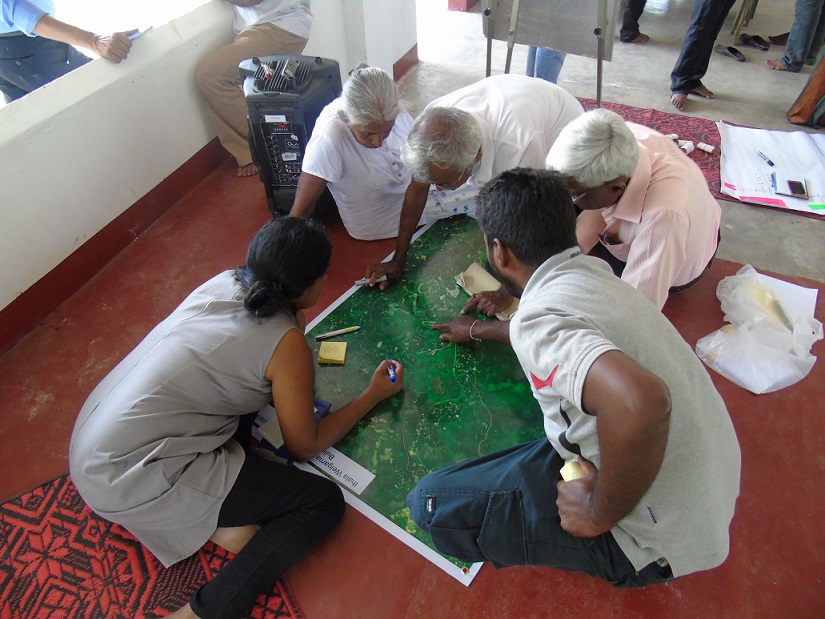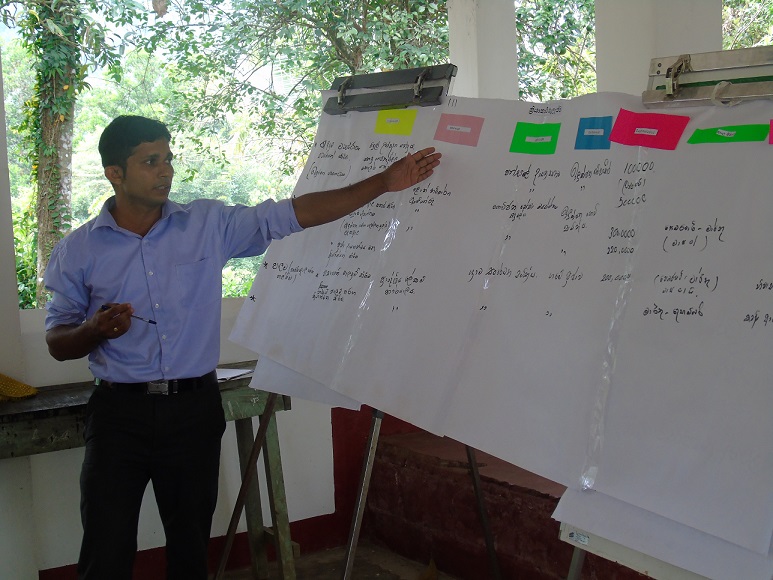Increasing Resilience for Flood and Drought Affected Areas through a Community Designed Action Plan
A workshop to gather inputs related to real-time experience of the community, their behavioural patterns and requirements during extreme flood and drought conditions was conducted on 11 February 2019 at the "Kithulgalwila Seemamalaka Viharaya" in Bulathsinhala.

Highlighting issues and locations on a map
Photo: Dinithi Samaratunga\© IUCN
About 40 people including Development Officers, Disaster Management Officers, Agricultural Officers, Tea and Rubber Research Officers, Grama Niladharis, religious leaders and villagers attended the workshop. Dr Ananda Mallawatantri, Country Representative of IUCN Sri Lanka introduced the project background while Mr Kalana Cooray, Mr Zihan Zarook, Ms Sadamali Pathirage and Ms Dinithi Samarathunga facilitated the workshop.
Funded by the International Labour Organization (ILO), IUCN Sri Lanka Office commenced implementing the project titled “Identification of Intervention Areas, Establishment of Baseline Information and Development of a Set of Pilot Projects in Kalutara and Ratnapura Flood-Affected Areas” (https://www.iucn.org/asia/countries/sri-lanka/identification-intervention-areas-establishment-baseline-information-and-development-a-set-pilot-projects-kaluthara-and-rathnapura-flood-affected-areas) in October 2018. Following several stakeholder consultative sessions and field visits, two project clusters have been selected to develop pilot interventions to improve flood resilience in the Ratnapura and Kalutara districts of Sri Lanka. The project cluster in the Kalutara District covers two Divisional Secretariat Divisions—namely Palindanuwara [covering Illukpotha Grama Niladhari Division (GND—village level Government staff)] and Bulathsinhala (covering Ihalawelgama and Thannahena GNDs).
The workshop was conducted for the communities in the three above-mentioned GNDs. During the proceedings of the workshop, related issues were discussed and a number of valuable comments from the community on their experience and impacts from both disasters were gathered. The participants worked in two groups to develop a work plan and the activities included increasing resilience through strengthening Disaster Management Centers; improving water distribution capacity for drinking and agriculture purposes by constructing an anicut at "Parevi Dola"; designing an access road to Palbima; waste management; promoting alternative livelihoods such as bee keeping, cattle farming, cultivation of medicinal plants, kithul (toddy palm) tapping, native fruit processing; the provisioning of canoes to be used during floods; and speedy action to minimize sand mining at Maguru Ganga.
 A development officer presenting proposed activities
Photo: Dinithi Samaratunga\© IUCN
A development officer presenting proposed activities
Photo: Dinithi Samaratunga\© IUCN
The comprehensive action plan developed by the community included sub activities, required resources, key responsibilities, stakeholders, cost estimates, implementing duration of proposed activities and indicators. As the next step, the proposed action plan will be validated at the workshop scheduled in March 2019.
